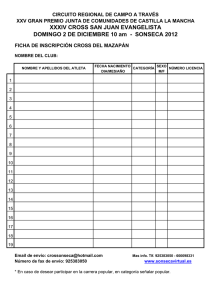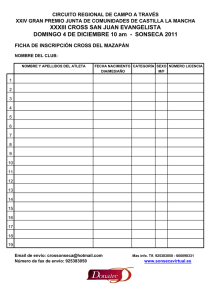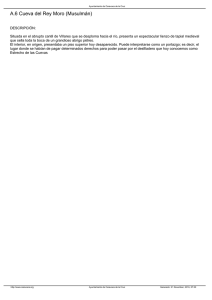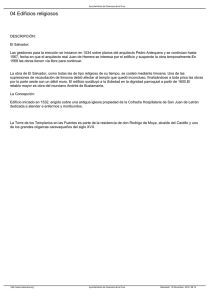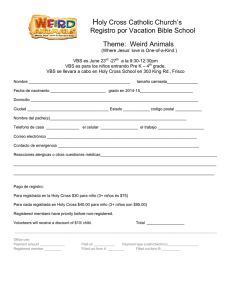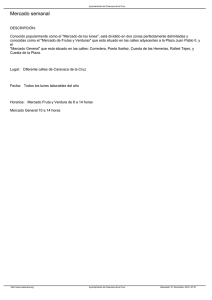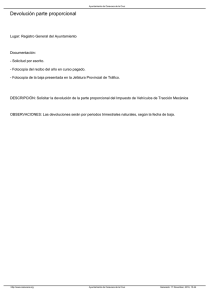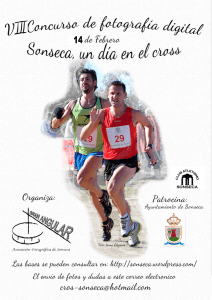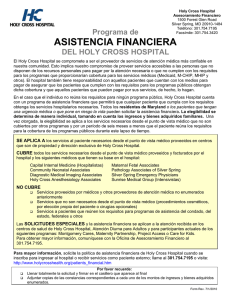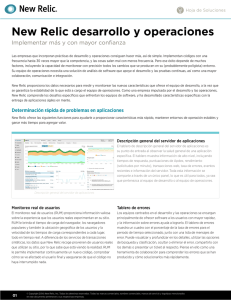Descargar folleto del Museo de la Vera Cruz
Anuncio
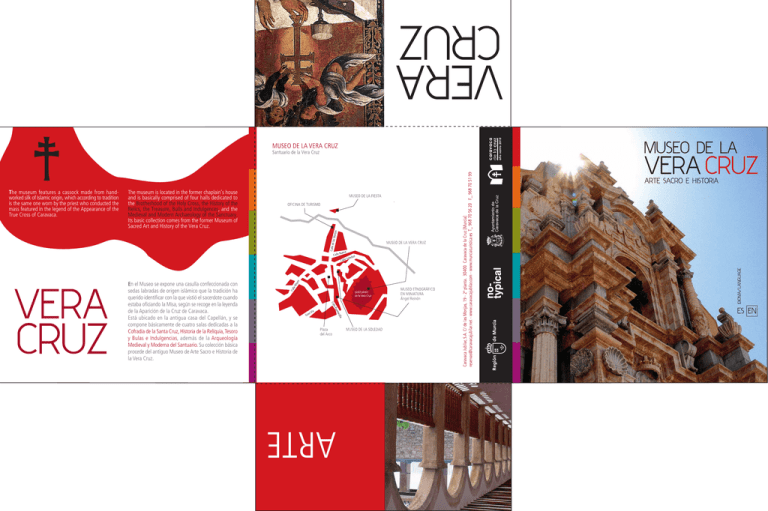
The museum features a cassock made from handworked silk of Islamic origin, which according to tradition is the same one worn by the priest who conducted the mass featured in the legend of the Appearance of the True Cross of Caravaca. The museum is located in the former chaplain’s house and is basically comprised of four halls dedicated to the Brotherhood of the Holy Cross, the History of the Relics, the Treasure, Bulls and Indulgences, and the Medieval and Modern Archaeology of the Sanctuary. Its basic collection comes from the former Museum of Sacred Art and History of the Vera Cruz. En el Museo se expone una casulla confeccionada con sedas labradas de origen islámico que la tradición ha querido identificar con la que vistió el sacerdote cuando estaba oficiando la Misa, según se recoge en la leyenda de la Aparición de la Cruz de Caravaca. Está ubicado en la antigua casa del Capellán, y se compone básicamente de cuatro salas dedicadas a la Cofradía de la Santa Cruz, Historia de la Reliquia, Tesoro y Bulas e Indulgencias, además de la Arqueología Medieval y Moderna del Santuario. Su colección básica procede del antiguo Museo de Arte Sacro e Historia de la Vera Cruz. RELIGIOUS ART La primera planta está dedicada a la Cofradía de la Santa Cruz y la Historia de la Sagrada Reliquia. La Sala principal recoge la historia de la Aparición de la Cruz en una doble vertiente: por un lado, la versión escrita por los cronistas locales de los siglos XVII y XVIII, Robles Corbalán y el padre Cuenca; por otro, la lectura iconográfica de los supuestos acontecimientos a través de las tablas pintadas que Hernando de Llanos realizó en 1521 para el retablo de la capilla de la Cruz. En la misma sala se expone la casulla realizada con tejido hispanomusulmán que la tradición popular atribuye a la que portaba el sacerdote cuando ofició la Misa de Aparición. También se muestra la arqueta de plata donada hacia 1390 por el maestre santiaguista Lorenzo Suárez de Figueroa, extraordinaria pieza de la orfebrería castellana, pero sobre todo de gran valor simbólico para los devotos de la Cruz, pues durante más de 600 años se ha utilizado para albergar diariamente al relicario del Lignum Crucis. AND HISTORY On display on the ground floor is a part of the Treasure of the Vera Cruz, in addition to some church bulls and letters of indulgence that have been granted by the Holy See to the devotees of the holy relic of Caravaca since the 14th century. Equally noteworthy are the monstrance, the base of which was donated in 1536 by Don Pedro Fajard o, the first marquis of the Vélez family and knight commander of Caravaca; the silver plated chest from the early 17th century; and the complete furnishings acquired for the inauguration of the temple in 1703, in addition to other interesting objects of silver such as the 18th century sceptres carried by the delegates of the cross during processions, and the “hand bells” chalice from the 17th century, a more recent offering from the Marquis of Alhucemas. In the basement of the building, we find impressive architectural remnants of the towers and walls of the ancient manorial castle that existed beneath the present day church and museum, as well as a foreboding, open pit dungeon where prisoners used to be kept. In another part of the castle, restorations have been carried out on the trench at San Lázaro gate, which was dug in 1811 during the war with the French, and the great medieval cisterns consisting of three and four chambers. The first floor is dedicated to the Brotherhood of the Holy Cross and to the History of The Holy Relic. The main hall recounts the story of the Appearance of the Cross in two ways: firstly, visitors learn the version written by two local chroniclers from the 17th and 18th centuries, Robles Corbalán and Father Cuenca; secondly, the story is divulged through the iconographic interpretation of the legendary events as depicted in panels painted by Hernando de Llanos in 1521 for the altarpiece of the Chapel of the Cross. The same hall houses the cassock made of HispanoMuslim cloth which popular tradition says was worn by the priest who conducted the Mass of the Appearance of the Cross. Also on display is a small silver chest, an extraordinary example of Castilian silversmithing, which was donated in about 1390 by the Grand Master of the Order of Santiago, Lorenzo Suárez de Figueroa. The chest is, above all, of great symbolic value to the devotees of the cross, since every day for more than 600 years it has been used to house the relic of the Lignum Crucis (wood of the true cross). TESORO En la planta baja se expone una parte del Tesoro de la Vera Cruz, además de algunas Bulas y Breves de Indulgencias que la Santa Sede ha concedido a los devotos de sagrada reliquia de Caravaca desde el siglo XIV. Destacan especialmente la custodia cuyo pie fue donado en 1536 por don Pedro Fajardo, primer marqués de los Vélez y comendador de Caravaca; la arqueta de planta sobredorada de principios del siglo XVII; y el ajuar completo adquirido para la inauguración del templo en 1703, además de otras interesantes piezas de plata como los cetros del siglo XVIII que portan en los diputados de la Cruz durante las procesiones o el cáliz de “las campanillas” del siglo XVII, limosna del marqués de Alhucemas en tiempos recientes. En el sótano del inmueble encontramos imponentes restos arquitectónicos del antiguo castillo señorial que existió bajo la actual iglesia y museo, compuesto de torres y murallas, además de una lúgubre y oscura mazmorra a cielo abierto donde se encerraba a los cautivos. En otro lugar del castillo también se han recuperado el foso de la puerta de San Lázaro, realizado en 1811 durante la guerra contra los franceses, y un gran aljibe medieval de tres naves.
